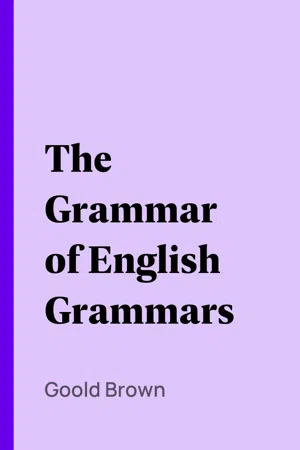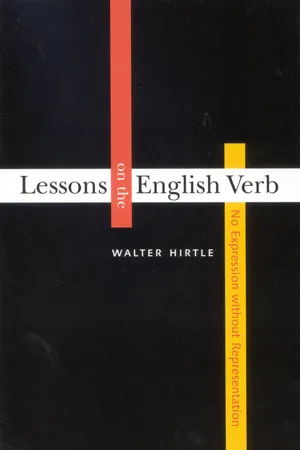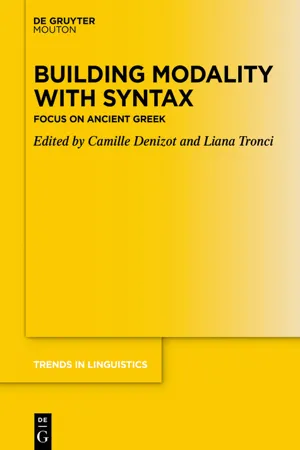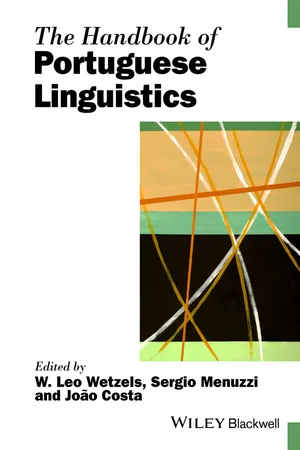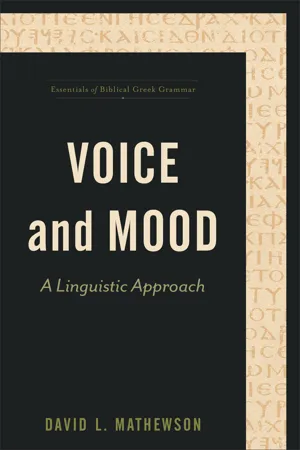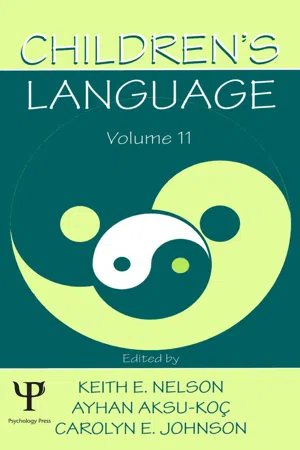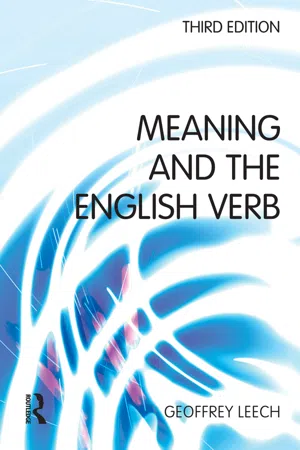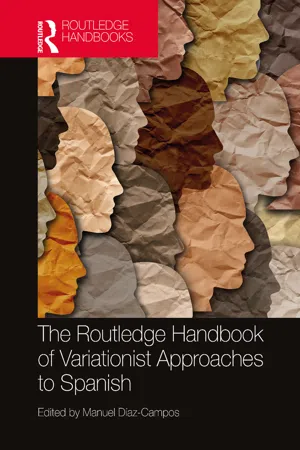Languages & Linguistics
Potential Mood
The potential mood is a grammatical mood that indicates possibility or potentiality. It is used to express what is possible, likely, or hypothetical. In many languages, the potential mood is formed using auxiliary verbs or specific verb conjugations to convey the idea of potentiality.
Written by Perlego with AI-assistance
10 Key excerpts on "Potential Mood"
- eBook - ePub
- Goold Brown(Author)
- 2004(Publication Date)
- Perlego(Publisher)
Some of these auxiliaries convey other ideas than that of power in the agent; but there is no occasion to explain them severally here. The Potential Mood, like the indicative, may be used in asking a question; as, " Must I budge ? must I observe you? must I stand and crouch under your testy humour?"— Shakspeare. No question can be asked in any other mood than these two. By some grammarians, the Potential Mood has been included in the subjunctive, because its meaning is often expressed in Latin by what in that language is called the subjunctive. By others, it has been entirely rejected, because all its tenses are compound, and it has been thought the words could as well be parsed separately. Neither of these opinions is sufficiently prevalent, or sufficiently plausible, to deserve a laboured refutation. On the other hand, James White, in his Essay on the English Verb, (London, 1761,) divided this mood into the following five: "the Elective," denoted by may or might ; "the Potential," by can or could ; "the Determinative " by would ; "the Obligative," by should ; and "the Compulsive," by must. Such a distribution is needlessly minute. Most of these can as well be spared as those other "moods, Interrogative, Optative, Promissive, Hortative, Precative, &c.", which Murray mentions only to reject. See his Octavo Gram., p. 68. OBS. 4.—The Subjunctive mood is so called because it is always subjoined to an other verb. It usually denotes some doubtful contingency, or some supposition contrary to fact. The manner of its dependence is commonly denoted by one of the following conjunctions; if, that, though, lest, unless. The indicative and Potential Moods, in all their tenses, may be used in the same dependent manner, to express any positive or potential condition; but this seems not to be a sufficient reason for considering them as parts of the subjunctive mood. In short, the idea of a "subjunctive mood in the indicative form," (which is adopted by Chandler, Frazee, Fisk, S. S - eBook - ePub
Lessons on the English Verb
No Expression Without Representation
- Walter Hirtle(Author)
- 2007(Publication Date)
- McGill-Queen's University Press(Publisher)
UNIVERSE TIME , since, like the spatial universe, it is conceived as capable of containing any temporal entity, any event. Mood, then, is the subsystem of the verb for representing universe time, time capable of containing any event, as opposed to aspect, the subsystem for representing event time, time contained in any event.Guillaume’s hypothesis was a major innovation. For the first time mood was related not to the attitude of the speaker but to what makes a word a verb, its role of consignifying time, of expressing time grammatically. Not only that: his hypothesis implied that without mood one cannot have tense incorporated into the verb because without a representation of universe time there would be no “other time” to situate an event in. The aim of this lesson is to apply the same hypothesis to English to see if it can provide us with a theory of how universe time is represented through the system of mood. Since there is little agreement among English grammarians on the question, a theoretical understanding of mood would provide a valuable basis for examining usage of the subjunctive and the nonfinite forms.THE INDICATIVE
We shall begin with the best known mood, the indicative, because its representation of universe time is more readily discernible thanks to the fact that an event is always located in relation to the present. This implies that somewhere in the endless stretch of time the present is represented as a point or limit dividing time already realized from time to be realized, as in the following diagram:Any event referred to time configured in this way will necessarily be situated to the left or right of the limit, or astride it.Since I want to show that a grammatical representation of the present in universe time is what characterizes the indicative mood, it is important to make clear at the outset that the term “present” is being used here in the technical sense proper to grammar. It is sometimes used in English grammars in just this sense: a limit or point or boundary that divides the whole horizon of time into two stretches but that is not itself a stretch of time, since a limit occupies no space and has no duration. This sense should be distinguished from that found in its common, non-technical use in “for the present,” “the present of speech,” etc., where it expresses not a limit but a short span of time containing the moment of awareness, the brief stretch during which we speak or listen, or do anything else, for that matter. The technical use here should also be kept quite distinct from the use found in grammars that speak of the “present tense,” a confusing manner of naming tense in English, as we shall see in the next lesson. - eBook - ePub
Building Modality with Syntax
Focus on Ancient Greek
- Camille Denizot, Liana Tronci, Camille Denizot, Liana Tronci(Authors)
- 2023(Publication Date)
- De Gruyter Mouton(Publisher)
My corpus comprises Homeric poems and the entire works of Sophocles, Euripides, Aristophanes, and Plato. This corpus was selected to study the evolution of the constructions from the 8th century BCE (Homer) to the 4th century BCE (Plato). It includes a wide variety of text types, particularly text structures with a high degree of interaction between speaker and addressee, such as dialogues and monologues in comedy (Aristophanes) and tragedy (Sophocles and Euripides), and dialogues and speeches to present reactive audiences (Plato).This paper is organised as follows. Section 2 briefly reviews relevant concepts in the field of mood and modality, Construction Grammar, and discourse and pragmatic functions. Section 3 presents the description of my data. Section 4 discusses the results and presents a tentative hypothesis of global interpretation. Finally, Section 5 summarises the conclusions.2 Theoretical basis
2.1 Mood and modality
Mood and modality can be used in at least two different meanings. In the first one, they are not conceptually different domains. Mood is the grammaticalisation of modal categories, as “modality is the conceptual domain and mood is its inflectional expression” (Bybee, Perkins and Pagliuca 1994 : 181; cf. also Palmer 1986 : 16). The terms mood and modality can also be used to express different contents. Thus, modality concerns the expression of possibility and necessity (epistemic and deontic modalities). In contrast, the term mood has come to be used to refer to (i) the domain of grammatical coding of modal (and related) meanings on the verb; (ii) the domain of basic sentence types and the illocutionary categories expressed by them; (iii) the domain of indicative vs subjunctive or realis vs irrealis coding and its semantics (Nuyts 2016 : 1–2). There is indeed an enormous polysemy in this use of the term mood, but it also occurs in the first meaning of the term modality. Therefore, I prefer to use the term mood for verbal moods, grammaticalised in a language for the expression of modality contents, and use the term modality - eBook - ePub
- Bas Aarts, April McMahon, Lars Hinrichs, Bas Aarts, April McMahon, Lars Hinrichs(Authors)
- 2020(Publication Date)
- Wiley-Blackwell(Publisher)
2002 , p. 173), or rather, involves a speaker’s judgment that a proposition is possibly or necessarily true or that the actualization of a situation is necessary or possible. But more semantically precise links between such meanings as we mention above are not forthcoming.In what follows, we shall work on the basis that all modal utterances are non‐factual, in that they do not assert that the situations they describe are facts, and all involve the speaker’s comment on the necessity or possibility of the truth of a proposition or the actualization of a situation. We will return to the discussion of theoretical problems concerning modality in Section 12.4.3 .Modality may be coded in various ways, including verbal inflections, auxiliary verbs, adverbs, and particles. The grammatical coding of modal meaning in verb inflections is known as mood (Thieroff 2010 ; van der Auwera and Aguilar 2016 ). English makes relatively little use of inflectional systems to express modal meanings: the imperative mood is common in English, and there is limited use of the subjunctive mood,2 but modality in English is primarily expressed by non‐inflectional items. These include a variety of elements, including adverbials like perhaps, in all probability, etc., and “hedges” like I would think (that) (cf., e.g., Hoye 1997 ; Krug 2000 ; Huddleston and Pullum 2002 , pp. 173–175; Portner 2009 , pp. 2–8). A very important means of expressing modality in English is the set of modal auxiliary verbs such as can, might, and must, and a considerable part of this chapter will be concerned with the meanings expressed by these auxiliaries. We will begin, however, with a brief look at mood in English.12.2 Inflectional Moods
In English, there are usually said to be three inflectional moods: the imperative, the subjunctive, and the indicative. The meanings they respectively communicate are captured quite nicely by the labels used by Jespersen (1949 - eBook - ePub
- W. Leo Wetzels, Sergio Menuzzi, João Costa, W. Leo Wetzels, Sergio Menuzzi, João Costa(Authors)
- 2016(Publication Date)
- Wiley-Blackwell(Publisher)
22 Mood and Modality RUI MARQUES AND ROBERTA PIRES DE OLIVEIRA“Hypotheticals, ‘imaginaries’, conditionals, the syntax of counterfactuality and contingency may well be the generative centres of human speech”(George Steiner, After Babel (1998), 226)1. This chapter
Mood and modality are closely intermingled and play a fundamental role in our lives: through them we express knowledge, and beliefs, about the world, as well as desires, conjectures, etc. These are important tools for surviving, as Hockett (1960) stressed. Languages vary greatly with respect to the ways they express the relations to the factual, the hypothetical, the counterfactual. This is a vast territory. In this chapter, our aim is twofold: empirically, we want to compare European Portuguese (EP) and Brazilian Portuguese (BP) with respect to mood and modality and show some of their differences; and we want to show that the relevant properties of Portuguese can be insightfully discussed with the tools provided by possible world semantics, in which semantic accounts of mood have appeared for different languages (cf. e.g., Farkas 1992, Portner 1993, Marques 2009, Giannakidou 2013).1We begin with mood in Portuguese, that is, the verb inflectional category associated with the expression of an attitude towards the proposition. Empirically, we will show that BP and EP differ with respect to the complement of some evaluative expressions, and of fiction verbs like imaginar (“to imagine”); moreover, we will show that the “future in the past” ( futuro do pretérito in BP grammatical terminology, and condicional in EP terminology) do not have the same interpretation in the two varieties. We also discuss why some tenses traditionally taken to belong to the indicative mood seem problematic under this classification: the futuro do pretérito/condicional itself, the pretérito imperfeito (“imperfect past”), and the futuro do presente - eBook - ePub
Voice and Mood (Essentials of Biblical Greek Grammar)
A Linguistic Approach
- Mathewson, David L., Porter, Stanley E.(Authors)
- 2021(Publication Date)
- Baker Academic(Publisher)
There has been much discussion in the grammars regarding the semantics of the subjunctive mood form. The subjunctive mood has been variously described as the mood of probability, desirable action, or intentionality, or as representing an action as uncertain but probable (see the survey of grammars above). These various semantic approaches and labels, however, not only reflect only some of the usages of the subjunctive, but also sometimes confuse reality with the author’s conception of reality, do not consider the relationship between the subjunctive and other mood forms, and do not get at the semantics of the mood that accounts for its various realizations in its contexts. Two proposals offer a more fruitful way forward. In his work on the moods in Indo-European languages, Gonda argues that the primary function of the subjunctive mood is visualization. “Its general function may, if I am not mistaken, have been to indicate that the speaker views the process denoted by the verb as existing in his mind or before his mental eye, or rather: as not yet having a higher degree of being than mental existence. The subjunctive, in other words, expresses visualization. A process in the subj[unctive] represents a mental image on the part of the speaker which, in his opinion, is capable of realization, or even awaits realization.” 29 Building off the work of Gonda, Porter suggests that the semantic feature that best characterizes the subjunctive mood is projection. Porter thinks that Gonda’s notion of visualization too closely suggests the creating of an image of the process in the mind. Therefore, Porter proposes the term projection as more adequately capturing the semantics of the subjunctive mood. The subjunctive thus could be defined as “the form. . - eBook - ePub
Children's Language
Volume 11: Interactional Contributions To Language Development
- Keith E. Nelson, Ayhan Aksu-Ko‡(Authors)
- 2005(Publication Date)
- Routledge(Publisher)
It is easy to see how the acquisition of such language would be dependent on the capacity for conceiving things as nonactual (i.e., on children’s meta-representational capacity; Papafragou, 1998). The three studies discussed in this chapter explore the relation between linguistic and cognitive development by looking at the correlations between children’s acquisition of a theory of mind, in particular, their capacity for representing false beliefs (Wellman, 1990; Wimmer & Perner, 1983), and their acquisition of mood selection in Spanish relative clauses. The chapter is organized as follows. In the first section I discuss the two principal linguistic markings of modality (i.e., mood and modals). In the second section I summarize the facts on children’s acquisition of modals in English and subjunctive in Spanish, and discuss some possible interactions between theory of mind development and acquisition of mood and modality. In the next section I present series of studies about mood selection in Spanish. In the final section, I conclude with a general discussion.Mood and Modality
Mood markers and modal verbs are the two main systems which natural languages use for encoding modality on the verb. Modality involves speaker evaluation of the actuality of the event referred to by a clause. In many languages, certain types of subordinate clauses are marked by means of a special verbal morphology known as subjunctive (Bybee, 1988). This subordinatingnonsubordinating distinction falls within what linguists call mood, that is, the grammatical category whose function is to describe the actuality of the event in terms such as possibility, necessity, or desirability (Chung & Timberlake, 1985). In Spanish, the syntactic distribution of the subjunctive is regulated by different factors in various contexts such that complement and adjunct clauses exhibit different distributions of the subjunctive mood. Semantically, the Spanish subjunctive is polysemous and can be associated with different semantic modalities. Two modalities seem most important in natural languages: epistemic modality and deontic modality. Epistemic modality evaluates the degree of speaker commitment to the truth of the proposition. Deontic modality (the modality of obligation/permission/possibility) evaluates the proposition with regard to the necessity or possibility of acts performed by morally responsible agents. Ability, predicated on a given agent, is grouped with deontic modality under the rubric of ‘root’ or ‘agent-oriented’ modalities. A given modal verb is typically ambiguous between a root and an epistemic reading. The following examples illustrate how the epistemic interpretation of can and must - eBook - ePub
- Geoffrey N. Leech(Author)
- 2014(Publication Date)
- Routledge(Publisher)
Chapter 8 Mood: Theoretica and Hypothetical Meaning161 mood: factual, theoretical and hypothetical meaning, THE SUBJUNCTIVE: 162 Present and Past Subjunctive, THEORETICAL MEANING: 163 factual and theoretical meaning, truth-commitment and truth-neutrality; 164 grammatical markers of factual and theoretical meaning; 165 putative should and the mandative subjunctive, CONDITIONAL SENTENCES: 166 real and unreal conditions; 167 real conditions; 168 constructions expressing theoretical meaning in if-clauses; 169 unreal conditions, HYPOTHETICAL MEANING: 170; 171 hypothetical meaning in dependent clauses; 172 in main clauses (implied conditions); 173 grammatical markers of hypothetical meaning; 174 relation between real and unreal conditions; 175 negative truth- commitment (‘contrary to assumption’ and ‘contrary to expectation’). HYPOTHETICAL USE OF MODAL AUXILIARIES: 176 indicated by Past Tense form; 177 regularities and exceptions; 178 past hypothetical meaning; 179 signs of fluctuating usage, SPECIAL HYPOTHETICAL USES OF MODAL AUXILIARIES: 180–83; 181 permission; 182 volition; 183 possibility; 184 three uses of might have; 185 ‘pure hypothesis’; 186 seven meanings of could.161Historically, the verbal category of Mood was once important in the English language, as it still is today in many European languages. By distinct forms of the verb, older English was able to discriminate between the Indicative Mood – expressing an event or state as a FACT, and the Subjunctive – expressing it as a SUPPOSITION . Further, the Present Subjunctive – conveying a REAL supposition (such as a plan for the future), was distinct from the Past Subjunctive – conveying an UNREAL - Manuel Díaz-Campos, Manuel Díaz-Campos(Authors)
- 2021(Publication Date)
- Routledge(Publisher)
Sociolinguistic research on mood distinction (the subjunctive–indicative contrast) in Spanish has indicated that native speakers are variable in their use of verbal moods and that this variation may be partly due to a slow, centuries-long change in progress in which, generally, the occurrence of the indicative increases and the occurrence of the subjunctive decreases (Silva-Corvalán, 2001). While geographical region has been found to be a possible source of variation (e.g., Gallego & Alonso-Marks, 2014a; García, 2011), studies that examine more than one geographical region in a single analysis are limited. Given that methodological differences exist across studies, it is challenging to make systematic comparisons across regions that have been examined in different investigations. Thus, there is a need for more work that compares multiple regions in a single research design. In light of this observation, the current study aims to more thoroughly understand the similarities and differences in the use of verbal moods in various geographical regions by analyzing three locations in a single investigation.2 Background
Mood distinction constitutes an example of morphosyntactic variation (cf. Schwenter, 2011). In Spanish, the alternation between the subjunctive and indicative moods arises predominantly in subordinate clauses, as in (1), though it also occurs in main clauses, as in (2). Data-driven research1 has examined numerous factors to better understand the ways in which speakers vary their use of verbal moods (e.g., de la Puente-Schubeck, 1992; García, 2011; Gudmestad, 2010; Torres Cacoullos et al., 2017; Waltermire, 2017). Examples of linguistic factors are semantic category of the governor, the governors themselves, time reference of the context, the hypothetical nature of the context, polarity, adjacency between the governor and the verb, and the complementizer that introduces a subordinate clause. Extralinguistic factors that have been investigated include mode, task, participant gender, and participant age.- (1) Vamos a la playa cuando hace/haga sol. ‘We go/we’re going to the beach when it is [INDIC/SUBJC] sunny.’
- (2) Tal vez llegamos/lleguemos tarde. ‘Perhaps we arrive [INDIC/SUBJC] late.’
Researchers have found that the frequency of use of verbal moods differs according to the semantic categories of governors, where the governor refers to a pre-verbal word or phrase that impacts the mood used. Semantic categories such as volition exhibit high rates of subjunctive use, and the indicative is often used in contexts of assertion2- eBook - ePub
- Janice Fon, Janice Fon(Authors)
- 2019(Publication Date)
- De Gruyter Mouton(Publisher)
7 The first type includes languages that express situational possibility with verbal affixes. The second type uses verbal constructions including auxiliary and serial verb construction, and the third group uses other kinds of markers. Among the 234 languages surveyed in van der Auwera and Amman (2013), the second type is the most frequent, while the third type is the least. The strategy to mark epistemic possibility is also divided into the three types, although the most dominant type is the third type. English and Chinese belong to the second type, while Japanese belongs the first type. The verbal constructions that express possibility in English and Chinese are mainly studied in the field of modality, while the potential suffixes in Japanese have to do with voice. As is commonly known, modality and voice are different fields of linguistics; one is a semantic category, and the other concerns grammatical relations. Although the study of each field has developed in its own way, little attention has been paid to their mutual relationship (except Narrog (2010)). This study tries to seek a way to integrate the two categories through a semantic analysis of possibility and its related meanings.1.2Possibility in English, Chinese, and Japanese
In English and Chinese, as well as many languages of the Indo-European family especially, possibility is an important concept in defining modality. Modality, which is often stated to express a speaker’s (subjective) attitudes and opinion, has plenty of definitions presented in the literature. Among the huge number of studies on modality, van der Auwera and Plungian (1998: 80) define modality as “semantic domains that involve possibility and necessity as paradigmatic variants”. They classify modality into four types as presented in Table 1 . 8 Although this definition of modality is rather restricted, it is useful to show the polysemy of modal auxiliaries in English and Chinese.Table 1: Modality type (extracted from van der Auwera and Plungian (1998: 82)).1.2.1Expressions of possibility in English
The English auxiliary Can was originally derived from the Old English verb cunnan which means ‘know how to’ (Goossens 1992). The meaning of this mental ability has extended to express physical ability and is further generalized to the use of ability in general. Participant-internal possibility including ability refers to a kind of possibility internal to a participant engaged in the state of affairs, as in (2).(2) I can lift this stone.Participant-external possibility, which is also called “situational possibility”, refers to circumstances that are external to the participant and make the state of affairs possible, as in (3). Deontic possibility is a subdomain of participant-external possibility, in which case the enabling or compelling circumstances are some person(s) or some social or ethical norm(s) (van der Auwera and Plungian 1998: 81). Permission expressed by May in (4a) is an example. May was originally derived from the Old English verb m æg , which means ‘have power to’. It started from physical ability and went through a similar development as Can
Index pages curate the most relevant extracts from our library of academic textbooks. They’ve been created using an in-house natural language model (NLM), each adding context and meaning to key research topics.
Explore more topic indexes
Explore more topic indexes
1 of 6
Explore more topic indexes
1 of 4
